Cast iron cookware are made from melting iron and other constituents and pouring it into a mold where it hardens into shape. Because of this, it is easier to make different types of cast iron cookware with varied shapes and sizes.
In this article, we’ll take a closer look at the different types of cast iron cookware available and explore their uses and benefits. Whether you’re a seasoned cook or new to cast iron, this guide will help you choose the right type of cookware for your needs and discover new ways to cook delicious meals.
The Different Types of Cast Iron Cookware

We will divide this guide into three parts: the first is for common types of cast iron cookware; the second will be reserved for bakeware, and the third will be used to discuss special and rare types of cast iron cookware,
Part 1: Common Types of Cast Iron Cookware
I lumped the following types of cast iron cookware together as they are the ones most used regularly. Chances are, you already have some of these in your kitchen.
Note: We will encounter the terms “pan” and “skillet” numerous times in this article. While they are often used interchangeably, they are semantically different. I like to think of it as an “every skillet is a pan, but not every pan is a skillet” type of situation.
The general description of a pan is any type of cooking vessel that is flat-bottomed. Meanwhile, skillets are specifically described to have sloping sides and long handles. Be that as it may, we’ll be referring to most of the other types of cast iron cookware here as pans and not skillets. Well, except for the first two items.
1. Skillet

A cast iron skillet is a frying pan with slightly sloping sides and a long handle. Its sloping sides make it easy to flip and toss food while cooking, and the long handle helps to keep your hands away from the heat. Bigger skillets usually have a loop handle on the opposite end of the long handle to aid in cooking techniques like tossing and stir-frying.
The skillet is the most ubiquitous cast iron cookware of them all, and you’ll probably find yourself using it a vast majority of the time.
2. Deep Skillet
A cast iron deep skillet is similar to a regular skillet but with higher sides. The higher sides of a deep skillet make it useful for cooking foods that require a lot of liquid or oil, hence why it is amenable to cooking techniques like deep frying, stewing, and braising.
More often than not, deep skillets come with a cast iron lid. While you should think twice before using the lid while deep frying, you can certainly use it for other slow-cooking techniques.
3. Dual Handle Pan
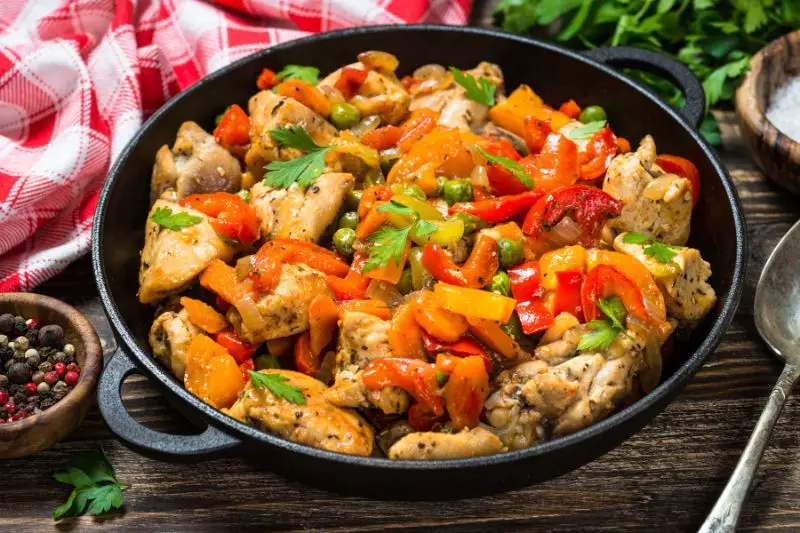
A dual handle cast iron pan features two loop handles on two opposite sides, rather than a single long handle like a traditional skillet. Since the weight of the pan is distributed more evenly between the two handles, you can easily maneuver it around the kitchen compared to the imbalanced load of the skillet. This is particularly useful if you need to tilt the pan when pouring out its contents.
The loop handles are also more compact than the long handles of skillets. This makes them fit better in ovens, and look better on the table as serveware.
4. Dutch Oven
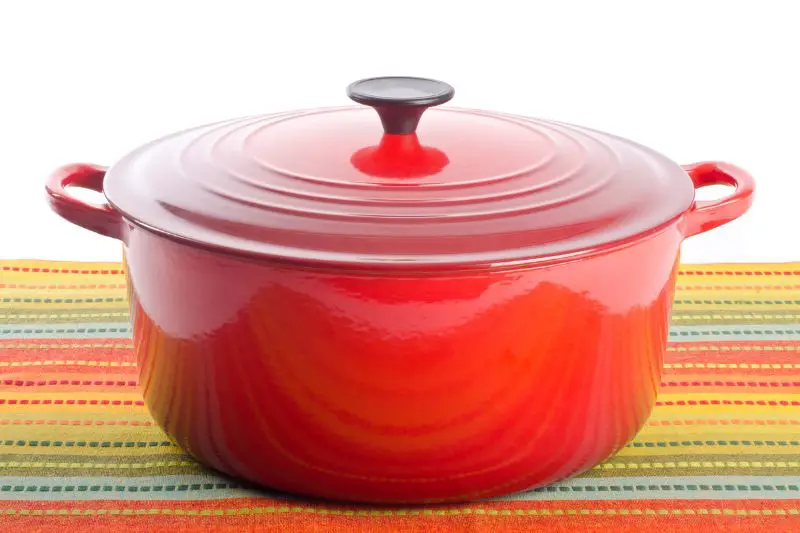
A Dutch oven is a heavy, wide, and thick-walled pot with a tight-fitting lid. The thick walls and heavy lid of the Dutch oven help retain heat and moisture. Some even come with a self-basting system of spikes or nipples on the underside of the lid so that steam will condense on these points and drip down to the food below, making it a great tool for slow cooking techniques like braising, stewing, and making soups. They can also be used for baking, roasting, and frying.
Dutch ovens are also known as “cocotte” in French (literally little pot) and are sometimes referred to as French ovens. While they may be similar, there are semantic differences between the two, which will be discussed in a separate article.
A variation of this classic design is the “double Dutch oven” (sometimes called a 2-in-1 Dutch oven). It is essentially a regular Dutch oven, but it uses a flat dual-handled pan as a lid instead of the traditional knob-handled lid. They can be used the same way as regular dutch ovens are used, but you can use the lid as a separate cooking vessel.
Most Dutch ovens are coated with a vibrantly colored enamel, adding a touch of style and elegance to the table.
Also read: A Complete Guide to Dutch Ovens: Size Chart, FAQs, and More!
5. Camp Dutch Oven
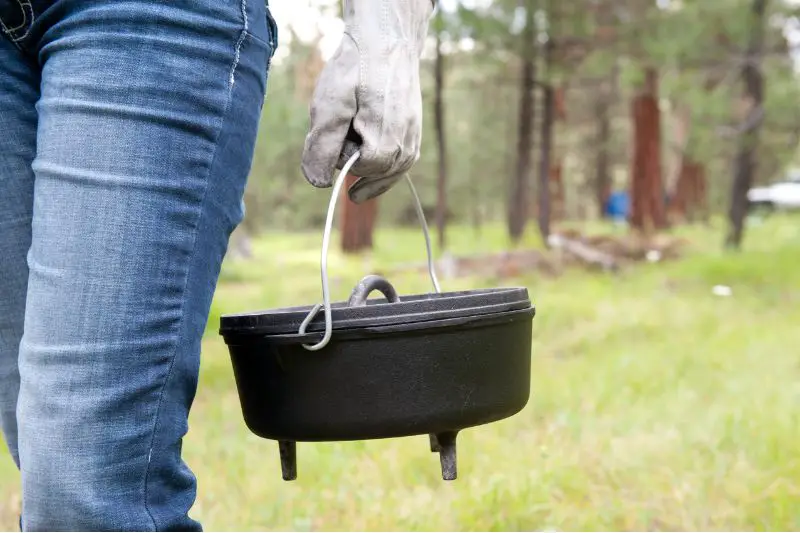
Before the popularity of enameled Dutch ovens, camp Dutch ovens were considered as the traditional design. It is a heavy-duty cast iron cooking pot with a tight-fitting lid and three short legs designed for cooking over an open fire. They also come with bail handles so that they can be hung over the fire for gentle simmering. Some models have lids with high rims that are meant to hold coals to ensure that the top part of the food also gets adequate heating.
Along with the cast iron skillet, camp Dutch ovens are a favorite of campers and outdoor cooks for their versatility and durability.
6. Braiser
A braiser is a type of cooking pan that is typically wider and shallower than a Dutch oven, and is designed for slow cooking, particularly braising. Like a Dutch oven, a braiser’s heavy lid will lock moisture in while cooking low and slow. However, unlike a Dutch oven, its wider and shallower stance allows for faster evaporation once the lid is off, making it easier to create reductions and thickening stews,
Braisers often come with an enamel coating, which is great as the stews and sauces you’ll be cooking in it will have acidic components that can react with bare cast iron.
Also read: Braiser vs. Dutch Oven: What’s the Difference (And Which One’s For You?)
7. Griddle
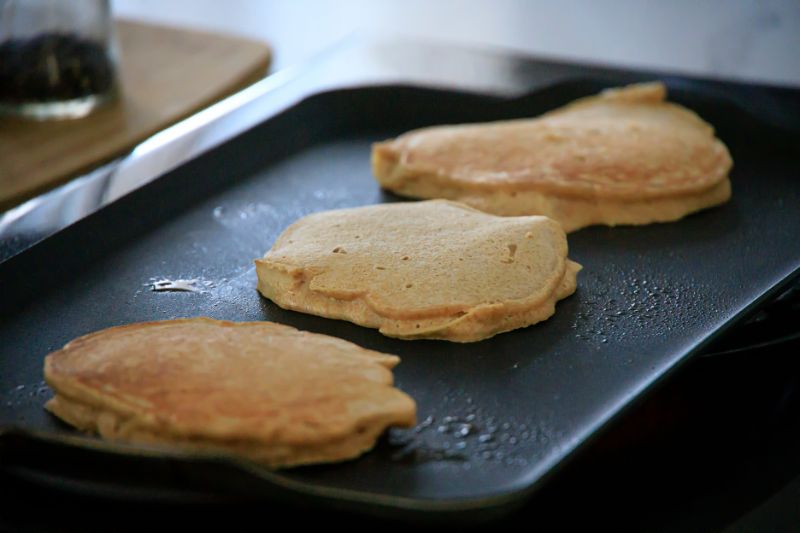
A cast iron griddle is a type of pan that is wide, flat, and extremely shallow, which makes it the best choice when frying a large batch of servings. They typically come in a long rectangular shape with loop handles on their two short edges. However, square and circle griddles with a handle attached
The wide cooking surface of griddles are useful when preparing a large batch of pan-fried meals, particularly for breakfast items. Total cooking time will also be significantly shorter with long rectangular models that can sit on two stove burners at once.
8. Grill Grates
A cast iron grill grate is a frame with metal bars that hold your food above the fire on a grill. Since grates are perforated, whatever it is that is cooking on the grill will be imparted with a savory and smoky flavor courtesy of the grill’s flames and smoke. The bars on the grates also impart cool grill mark patterns on your meals.
Also read: Cast Iron Grill Grates 101: A Complete Beginner’s Guide
9. Grill Pan

A grill pan is a type of pan that has raised ribs in its cooking surface to create the grill marks commonly achieved in an outdoor grill. One advantage that a grill pan has over grill grates is that it can be both outdoors on a grill and indoors on a stovetop. However, unlike a grill, you may not find the same savory and smoky flavor that grill grates achieve as grill pans are not perforated, hence, no flame or smoke will come into contact with your food.
10. Reversible Grill/Griddle
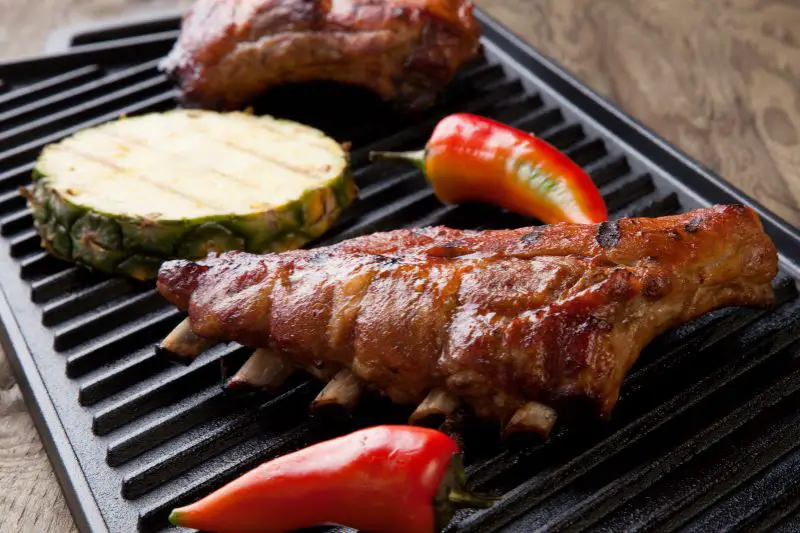
A reversible grill/griddle is a type of cast iron cookware that features a ridged cooking surface of a grill pan on one side and a flat cooking surface of a griddle on the other. This tool gives home cooks versatility as it allows them the option to either fry or grill without having to buy separate cookware for each.
11. Sauce Pan
A saucepan is a type of pan that is used for cooking and serving sauces. They are typically small and have tall sides, which allows liquids to be whisked and stirred without spilling. Some models may feature a spout or pour lip for easy pouring of the sauce.
Since sauces often have acidic components in their recipes, most cast iron saucepans are coated with enamel to prevent the acids from reacting with the seasoning of unenameled cast iron pans.
12. Wok

A wok is a deep and round-bottomed cooking utensil that is popular in Asia. Its bowl-like shape allows for easy tossing and stirring of ingredients during cooking, and its high sides are perfect for catching the flames of high-powered Asian stoves. The intense heat that can be generated by a Wok burner allows for quick cooking, which preserves the color, texture, and flavor of the ingredients. This makes them perfect for stir-frying vegetables and meats. However, they can also be used for a variety of techniques like deep frying, braising, boiling, and steaming.
Woks can come with a long wooden handle or have a pair of looped handles called “ears”. Modern woks may also have a flat bottom that is more amenable for use on a Western-style stove.
Also read: A Complete Guide to Woks: Choosing, Using, Seasoning, and More!
Part 2: Types of Cast Iron Bakeware
Many people like cast iron cookware as they are versatile in the kitchen. Since they can withstand high heats without melting or any kind of damage, they can be used in the stove, on the grill, or for baking.
Some of the items listed in the previous section, like skillets, dutch ovens, braisers, and dual-handle pans can be used in some capacity as bakeware; this section covers the other types of cast iron cookware that are specially designed for baking.
13. Cake Pan
A cake pan is a type of baking dish with high, straight sides, and flat bottoms that are meant to form the structure of cakes. Cast iron cake pans come in a variety of sizes and shapes, including round, square, and rectangle.
Cake pans made from other materials like aluminum and stainless steel may have a removable bottoms or even a springform mechanism to easily release cakes from the mold. Unfortunately, those features are not available in cake pans made from cast iron. However, properly seasoning your cake pan will ensure that your cake will easily release from the pan without damage.
14. Tube Pan
A tube pan is a type of baking pan that has a cylindrical shape with tall straight sides, and a hollow tube running at the center. The tube allows cakes to cook more evenly, which is essential when baking cakes with beaten egg whites like angel cakes and chiffon cakes. However, it can also be used to roast vegetables and meat. The tube is often used to spit roast a whole chicken.
Tube pans made from other materials like aluminum and stainless steel may have a removable bottom feature to easily release cakes without sticking. Unfortunately, that feature is not available in tube pans made from cast iron. However, if your tube pan is properly seasoned, you won’t have much problem releasing your cake from the pan.
15. Bundt Pan
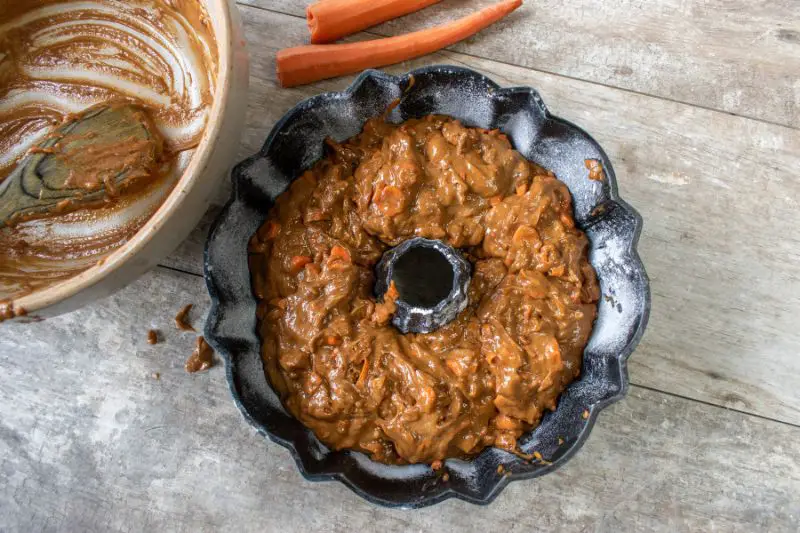
A bundt pan is similar to a tube pan as it also has hollow tube running at the center of the pan, except that it has fluted or grooved sides. Because of this, they are generally called “fluted tube pans”; the name “Bundt” is actually a trademarked name for a specific brand of fluted tube pans.
The decorative shapes of bundt pans come in various designs and patterns. Bundt pans are often used to make pound cakes, gelatine, and other baked desserts. However, much like a tube pan, they can also be used for meats and vegetables, though they are typically smaller and have much less space to work on due to their decorative flourishes.
16. Loaf Pan
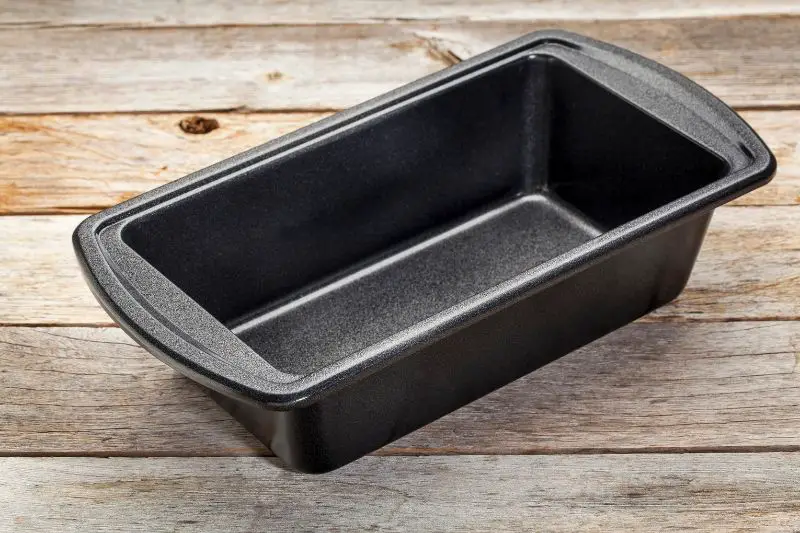
A loaf pan, sometimes called a bread pan, is a rectangular baking pan with straight sides and a flat bottom that is typically used for making loaves of bread, but can also be used for baking meatloafs and other types of desserts. They come in a variety of sizes, with the most common being 9 inches by 5 inches.
Most loaf pans come without a lid. However, loaf pans with lids often differ in design. Flat lids prevent the bread from rising over the pan’s rim. This yields perfectly square loaves as opposed to “mushroom cap” loaves.
17. Muffin Pan
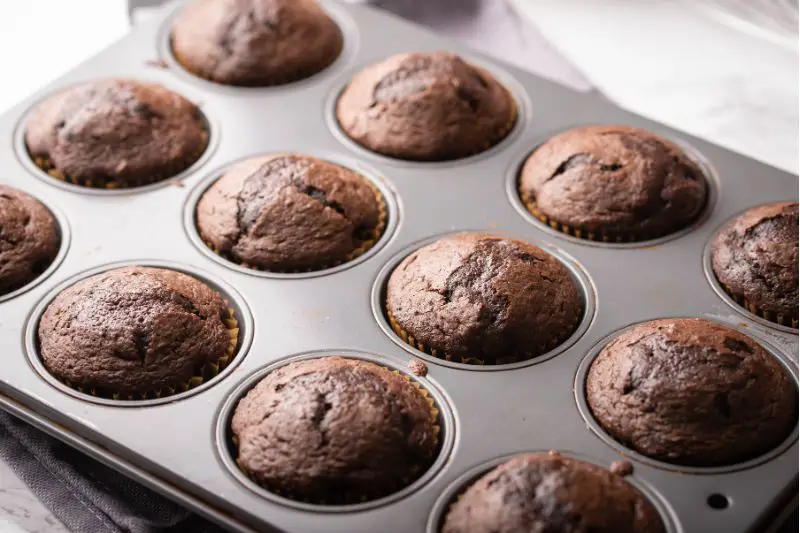
A muffin pan is a baking pan with multiple individual indentations that are used to bake muffins, cupcakes, and other small baked goods. The cups are round and shallow, with the top coming slightly wider than the bottom. This shape allows muffins and cupcakes to rise evenly and form a nicely domed top.
Muffin pans can come with 6 to 24 cups per tray. They can be had with straight sides or fluted sides.
18. Pie Pan
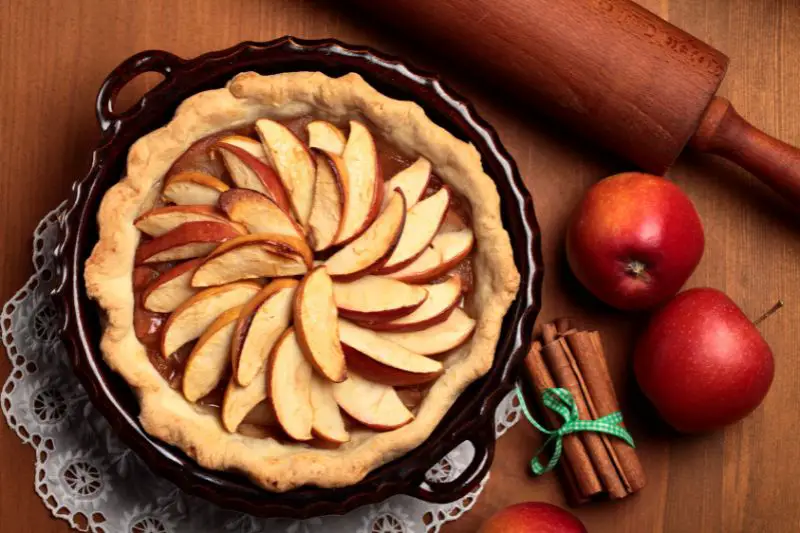
A pie pan is a shallow, round dish with sloping sides as opposed to the straight sides of a cake pan. Some pie pans also come with decorative designs like fluting and scalloping to create an attractive border for the crust. They are used for baking pies, tarts, and quiches.
Pie pans made from aluminum or stainless steel often have removable bottoms, which can make it easier to remove the pie from the pan once it has cooled. However, cast iron pie pans do not have this luxury, but keeping them well-oiled and seasoned will ensure that your pie will easily release from the pan.
19. Pizza Pan

A pizza pan is a wide and shallow pan that is used to bake pizzas. They can either come with rims or without them – rimless pizza pans are often used for thin-crust pizzas.
Cast iron pizza pans are often solid, but there are some perforated cast iron pizza pans available in the market. The small holes on the bottom of a perforated pan allow air to circulate under the pizza, and prevent it from absorbing excess oils.
20. Roasting Pan
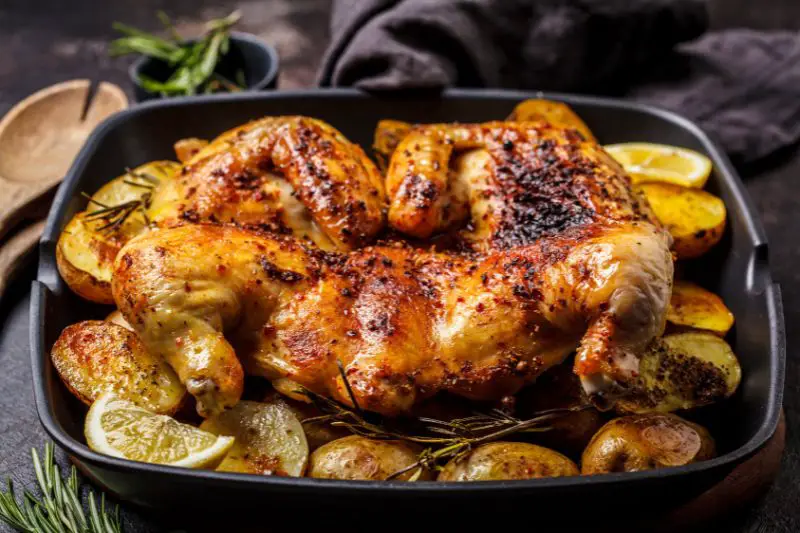
A roasting pan is a flat and deep pan that is used for roasting meats and vegetables. Its tall sides are ideal for keeping liquids and pan drippings in check to avoid spillage. Their shape and size may vary, with elliptical and rectangular shapes being the most commonly available in the market.
Most roasting pans don’t come with a lid, but that can be solved by covering the top part with foil during cooking to prevent the dish from drying out or excessively browning from the top.
21. Sheet Pan

A sheet pan is a flat, rectangular pan that is used for baking. While it is similar to a roasting pan, sheet pans are differentiated by their shorter sides for quicker cooking. However, they are prone to spillage of liquids and pan drippings. Because of this, they are often used for baking pastries and bread and roasting dishes on the dryer side of the spectrum.
Part 3: Types of Specialty Cast Iron Cookware
Apart from the classic and versatile types of cast iron cookware, there are also some designs that are more niche and only good for doing pretty much one thing, and that one thing well. Here are some of the specialty cast iron cookware available in the market.
22. Aebleskiver Pan

An Aebleskiver pan is used to make a traditional Danish dish called Aebleskiver, a spherical-shaped pastry that is often filled with jam, and apples, and dipped in powdered sugar. The Aebleskiver pan has 7 to 9 round wells that form the spherical shape of this delicacy. They are usually made from cast iron, though the most traditional ones are made from copper.
Aebleskiver pans are commonly found in Denmark and other Scandinavian countries and are also becoming popular in other parts of the world as people discover this delicious pastry. With that said, it can double as a Takoyaki pan (more on this later) should the need arise.
23. Cornstick Pan

A cornstick pan is a type of cast iron baking pan with multiple corn-shaped molds to make corn sticks – a popular type of cornbread in the Southern United States. The molds are typically 4 to 5 inches in length, and depending on the size of the pan, number 5 to 9 side-by-side. Because of its unique shape, it cannot be used for making any other type of dishes.
24. Crepe Pan

A crepe pan is a shallow, flat pan with a wide diameter and low sides, which are designed to make crepes. Crepes are thin, delicate pancakes that require a gentle touch to prevent it from ripping apart. Crepe pans are often bundled with a specialized crepe spatula to aid you in flipping and removing crepes.
Because of its shape, a crepe pans can double as a small griddle or frying pan. With that said, you can also make crepes in a griddle – what’s important is that you have a spreader for the batter and a spatula for the job.
25. Discada
A discada (also known as a cowboy wok) is a very wide cooking pan – measuring 20 to 24 inches wide, that is used for outdoor cooking. It also has a concave design reminiscent of a shallow wok. Because of this, discadas often have uneven heating, with the center being very hot while the outer sides are relatively cooler. You can exploit this quirk by cooking different ingredients with varying heat requirements in one large pan.
The discada is actually a versatile design, but relatively hard to come by. Traditionally, they were made from repurposed plow discs, but now they are purpose-made for cooking. They are commonly made of carbon steel, but cast iron discadas are also available in the market.
26. Donut Pan
A donut pan is a specialized bakeware with individual donut-shaped molds that is used to make donuts in a convenient and consistent manner. Donut pans are available in different sizes and shapes, including traditional round donuts, mini donuts, and even heart-shaped donuts.
The donut pan is designed to make baking donuts easier and more efficient than traditional methods. The donut-shaped molds ensure that each donut is the same size and shape, which is difficult to achieve when making donuts by hand. Also, it allows you to stick to the healthier option by baking your donuts instead of frying them in oil.
27. Meat Press
A cast iron meat press is a flat, heavy plate with a handle on top that is used to apply pressure on meats so that they would lay flat on the grill or griddle, resulting in a more even sear. The weight of the meat press helps to prevent curling or warping of the meat during cooking, which can also speed up the cooking process, particularly for thinner cuts of meat. It can also be used for paninis!
Meat presses can come in either a round or rectangular shape. They mostly have wooden handles or metal coiled handles that do not get hot to the touch. Also, the features on the underside vary per brand – some are flat, and others have ridges that create grill mark patterns on top of meats. Just make sure to preheat the meat press over the flame before pressing it over a piece of meat.
28. Melting Pot
A cast iron melting pot is a small, deep pot made of cast iron that is used for melting or heating small quantities of food like chocolate, sauces, cheese, and butter. These small pots sport a long handle and a spout to make pouring melted ingredients out of the vessel easier.
Melting pots come in various sizes, with smaller ones typically holding around 1 to 2 cups of liquid and larger ones holding up to 4 cups.
29. Mongolian BBQ Grill Pan
A Mongolian BBQ grill pan, also known as a Genghis Khan grill pan, is a circular pan with a convex dome in the middle that is used for grilling meats. The convex-shaped dome in the middle allows fats and liquids to drain off while cooking. Commonly, this item is sold as a pan with bail handles. However, some models come with a coal-powered stove attached below the pan.
Despite its name, it is not actually from Mongolia. The most popular version of the story revolves around how the Japanese adapted the practice of the Mongolian horde, whose soldiers use helmets to grill meat while on a campaign. Inspired by this, the Japanese made pans shaped like helmets for grilling meats. However, much of this is pure speculation. Be that as it may, it is a cool-shaped pan that will make a great addition to a cast iron aficionado’s collection.
30. Novelty Pans
Novelty cast iron pans are designed with a unique and often whimsical shape or design, making it more of a decorative or collector’s item than a functional cooking tool. From animals, symbols, cartoon characters, and even US states, the sky is the limit when it comes to designs.
While novelty cast iron pans can be used for cooking, they are not always as practical or functional as traditional cast iron pans, as their unique shapes may make it more difficult to cook certain types of foods or clean the pan thoroughly. However, they can still be a fun and unique addition to any kitchen and can be used to add a touch of personality to your kitchen.
31. Paella Pan
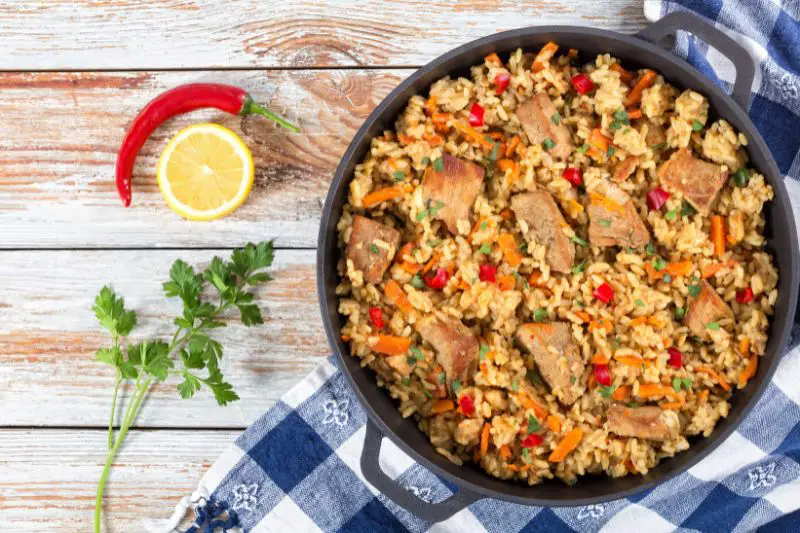
A paella pan is a wide and shallow cooking pan that has been traditionally used to cook the Spanish dish, paella. The pan’s wide, shallow design makes it ideal for cooking dishes that need to be spread out in a single layer, allowing for even cooking and browning.
While it may look strikingly similar to a dual-handled cast iron pan, one of the tells that it specializes in cooking paella is the gentler sloping of its sides. Paella pans come in different sizes, with smaller or larger servings in mind.
32. Panini Press
A cast iron panini press is a ribbed, heavy plate with a handle on top that is used to apply pressure on sandwiches to impart grill marks on the bread. To use a cast iron panini press, preheat it on the stovetop or over a grill until it reaches the desired temperature. Best paired with a cast iron grill pan to get the grill marks on both sides.
You can use the panini press the same way you use a meat press. However, keep in mind that panini presses are typically smaller and lighter than purpose-made meat presses.
33. Sizzler Plate
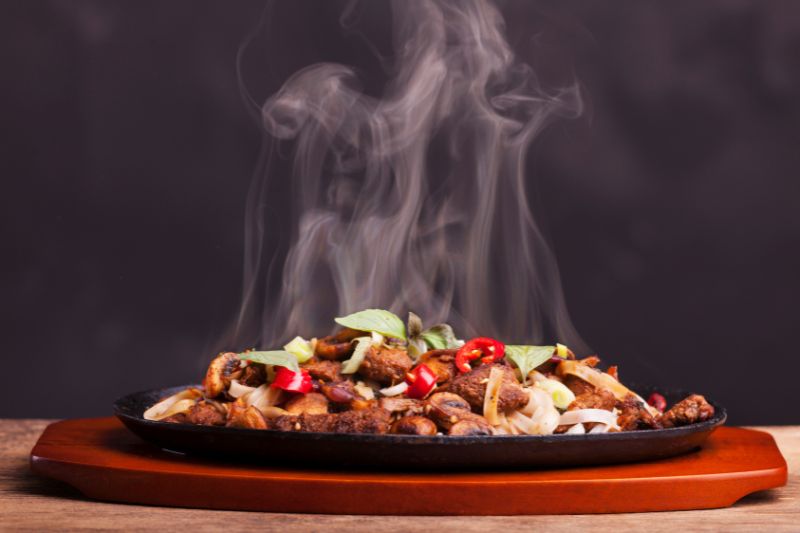
A cast iron sizzler plate flat, round, or oval serving dish that is used to serve hot and sizzling dishes like fajitas and steak. While you can certainly do those things in a cast iron skillet, a sizzler plate is smaller and will fit easier in a dining setting to enhance the presentation. It is often paired with a wooden trivet to prevent the surface of the table from getting burn marks.
While you can cook in a sizzler plate (albeit with difficulty because of the small size), it is designed to be heated on the stovetop or in the oven until it’s extremely hot, and then the hot food is placed directly onto the plate. This will create a sizzling sound and intensify the aroma of the dish to add an element of excitement and theater to the dining experience.
Also read: How to Use a Sizzler Plate: A Quick Start Guide
34. Stovetop Waffle Iron
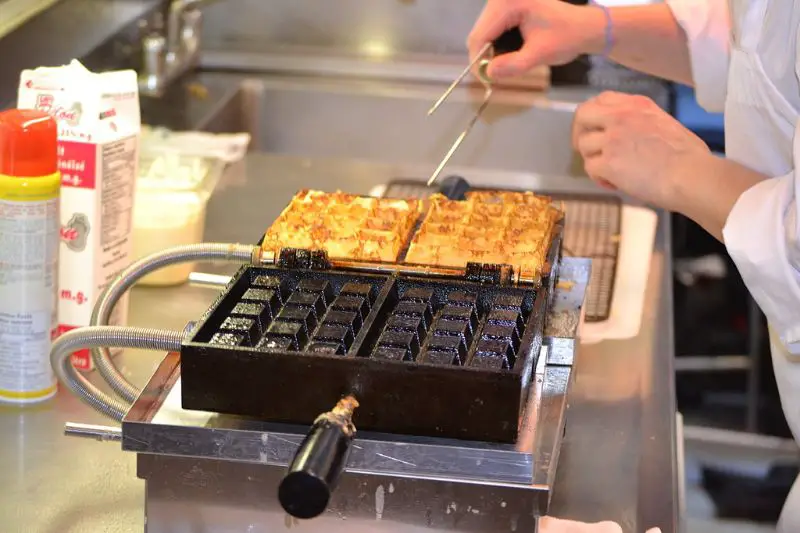
A stovetop waffle iron is a kitchen utensil that is used to make waffles the old fashioned way. Just like its electric counterpart, it consists of two hinged plates that are designed to be heated over a stove or on a campfire.
To make waffles, you must pour batter onto one plate, and the other plate is closed to form the classic waffle shape. The waffle iron is flipped over to cook the other side until the waffle is done.
Also read: How to Make Waffles on the Stove: A Quick Guide for Beginners
35. Taiyaki Pan
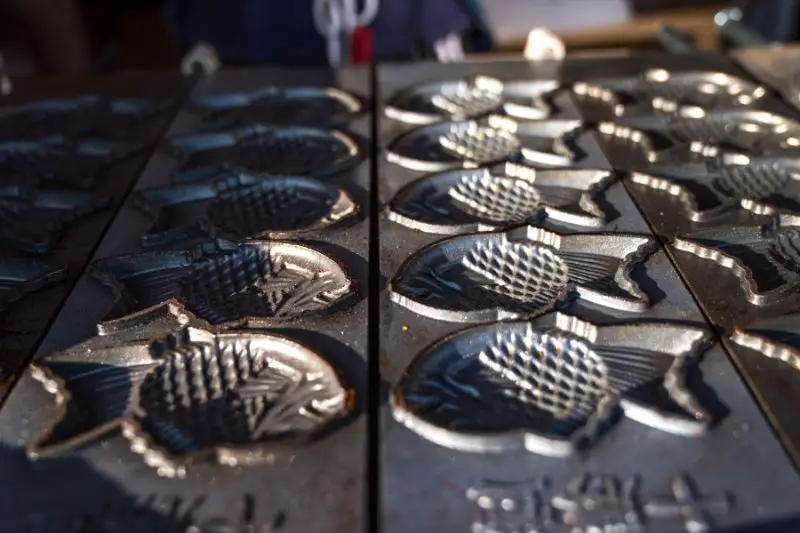
A taiyaki pan is essentially a waffle maker with fish-shaped molds that is used to make the Japanese street food called taiyaki – a fish-shaped waffle with a sweet red bean paste filling. Taiyaki pans typically have two fish-shaped molds in one pan. However, those used for commercial purposes typically have 3 to 5 molds side by side. Because of its unique shape, I do not see any other uses for it aside from making taiyaki – well, unless you want a fish-shaped cornbread.
36. Takoyaki Pan
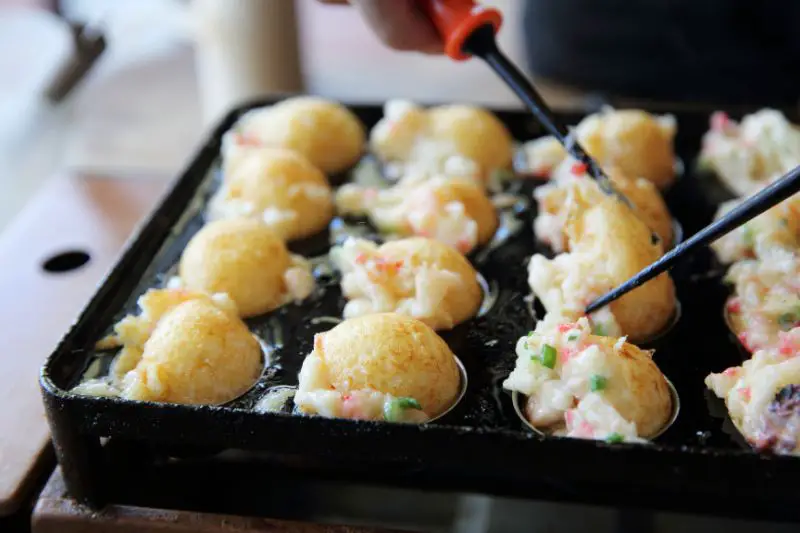
A takoyaki pan is used to make a popular Japanese street food called takoyaki – small, ball-shaped pancakes filled with diced octopus and other vegetables. The pan has several round wells to form the signature takoyaki shape. Once the batter has formed a half-sphere shape, they are flipped with chopsticks to complete the spherical shape of takoyakis.
Takoyaki pans come in different sizes and can have different numbers of molds. With that said, most pans for household use have 12-14 holes in them. They look a lot like aebleskiver pans, however, takoyaki pans typically have smaller molds compared to aebleskiver pans, but the difference may not be too significant. So it is safe to safe you can use an aebleskiver pan to make takoyakis and vice-versa.
37. Tamagoyaki Pan
A tamagoyaki pan is a rectangular cooking pan – and uniquely, a sloping end – that is used to make the traditional Japanese rolled omelet called tamagoyaki. The sloping end will allow you to tilt the pan forward, which can help you easily roll and flip the omelet to create a perfectly layered tamagoyaki. Outside of omelet, you can use this pan just like any other, though the amount you can cook in it will be limited due to its size.
38. Tetsubin
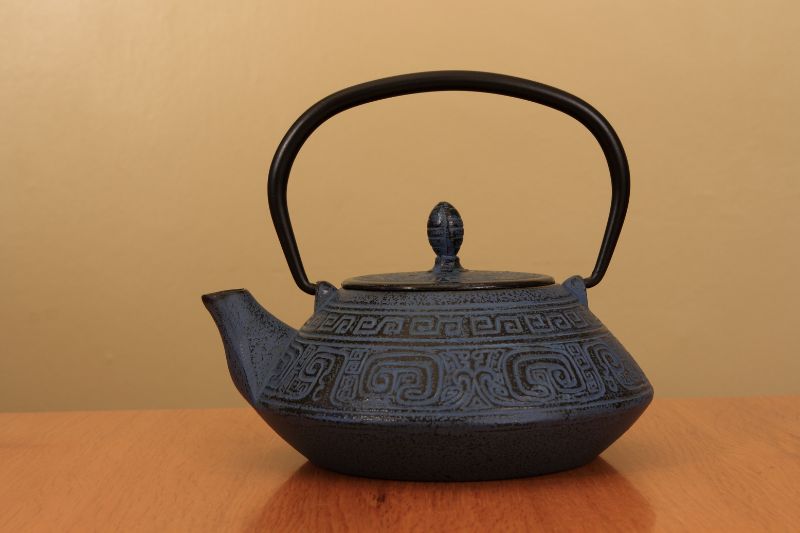
A tetsubin (literally means iron pot in Japanese) is a traditional Japanese cast iron teapot that has been used to brew and serve tea for centuries. The interior of the teapot is often coated with enamel to prevent rust from contaminating the tea and make it easier to clean.
They are often decorated with intricate designs and relief patterns and are often treated more as pieces of artwork by collectors and tea enthusiasts. With that said, there are tetsubins that are utilitarian as well.
39. Tortilla Press
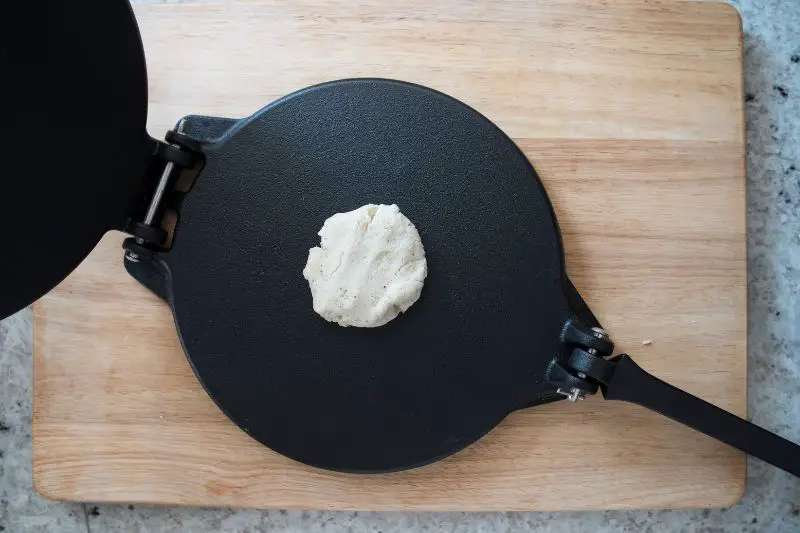
A tortilla press is a kitchen tool that is used to make tortillas. It has two flat plates with a hinge mechanism that allows the user to press down on the tortilla dough to flatten it. Pressing your the dough is a quicker and more consistent alternative to using a rolling pin.
40. Wedge Pan
A wedge pan is a type of baking pan that is shaped like a wedge or a slice of pie. It is typically used to make wedges of cornbread, but it can also be used to bake small, individual servings of pies or cakes. Wedge pans can also be used to bake savory dishes such as quiches, frittatas, or mini pot pies.
Conclusion
I hope that you’ve enjoyed this exhaustive list of the different types of cast iron cookware for home cooks. Also, I hope that this spreads the cast iron collection bug to you as well. Apart from the joy of collecting, you can rest easy in the fact that no matter which type of cast iron cookware you choose, it can last for generations and continue to be a reliable tool in your kitchen when given with proper care and seasoning.
If you’re still hungry for more info about cast iron and other cookware made from carbon steel, stainless steel, copper, and aluminum, then be sure to check out the rest of the Cult of Cast Iron blog!

Miguel is a cast iron enthusiast from Cavite, Philippines. He works in the digital marketing field as a content marketing strategist. On the side, he manages a small online bookstore and tends to his plants.

